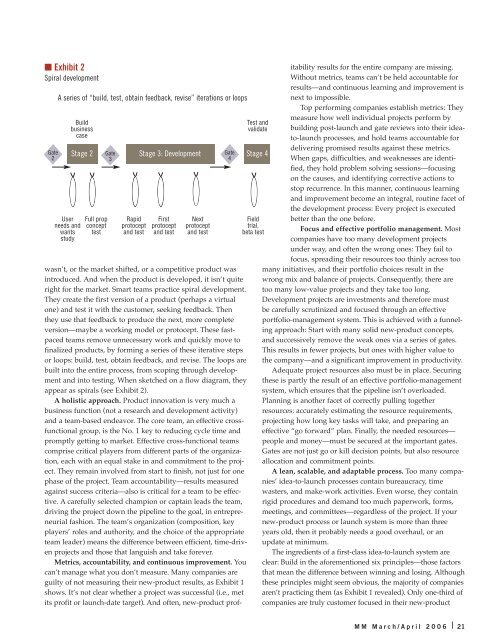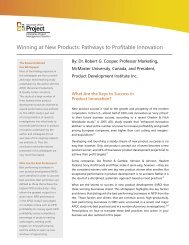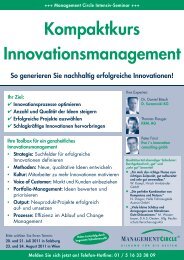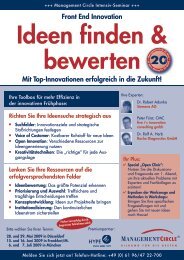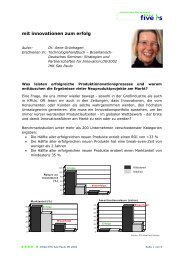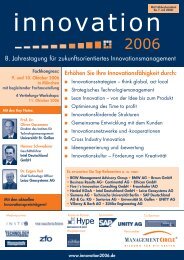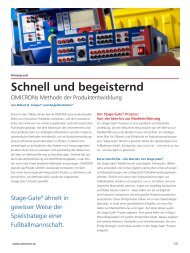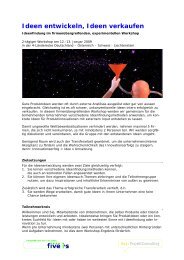The seven principles of the latest Stage-Gate
The seven principles of the latest Stage-Gate
The seven principles of the latest Stage-Gate
You also want an ePaper? Increase the reach of your titles
YUMPU automatically turns print PDFs into web optimized ePapers that Google loves.
■ Exhibit 2<br />
Spiral development<br />
<strong>Gate</strong><br />
2<br />
A series <strong>of</strong> “build, test, obtain feedback, revise” iterations or loops<br />
Build<br />
business<br />
case<br />
User<br />
needs and<br />
wants<br />
study<br />
Full prop<br />
concept<br />
test<br />
Rapid<br />
protocept<br />
and test<br />
First<br />
protocept<br />
and test<br />
Next<br />
protocept<br />
and test<br />
wasn’t, or <strong>the</strong> market shifted, or a competitive product was<br />
introduced. And when <strong>the</strong> product is developed, it isn’t quite<br />
right for <strong>the</strong> market. Smart teams practice spiral development.<br />
<strong>The</strong>y create <strong>the</strong> first version <strong>of</strong> a product (perhaps a virtual<br />
one) and test it with <strong>the</strong> customer, seeking feedback. <strong>The</strong>n<br />
<strong>the</strong>y use that feedback to produce <strong>the</strong> next, more complete<br />
version—maybe a working model or protocept. <strong>The</strong>se fastpaced<br />
teams remove unnecessary work and quickly move to<br />
finalized products, by forming a series <strong>of</strong> <strong>the</strong>se iterative steps<br />
or loops: build, test, obtain feedback, and revise. <strong>The</strong> loops are<br />
built into <strong>the</strong> entire process, from scoping through development<br />
and into testing. When sketched on a flow diagram, <strong>the</strong>y<br />
appear as spirals (see Exhibit 2).<br />
A holistic approach. Product innovation is very much a<br />
business function (not a research and development activity)<br />
and a team-based endeavor. <strong>The</strong> core team, an effective crossfunctional<br />
group, is <strong>the</strong> No. 1 key to reducing cycle time and<br />
promptly getting to market. Effective cross-functional teams<br />
comprise critical players from different parts <strong>of</strong> <strong>the</strong> organization,<br />
each with an equal stake in and commitment to <strong>the</strong> project.<br />
<strong>The</strong>y remain involved from start to finish, not just for one<br />
phase <strong>of</strong> <strong>the</strong> project. Team accountability—results measured<br />
against success criteria—also is critical for a team to be effective.<br />
A carefully selected champion or captain leads <strong>the</strong> team,<br />
driving <strong>the</strong> project down <strong>the</strong> pipeline to <strong>the</strong> goal, in entrepreneurial<br />
fashion. <strong>The</strong> team’s organization (composition, key<br />
players’ roles and authority, and <strong>the</strong> choice <strong>of</strong> <strong>the</strong> appropriate<br />
team leader) means <strong>the</strong> difference between efficient, time-driven<br />
projects and those that languish and take forever.<br />
Metrics, accountability, and continuous improvement. You<br />
can’t manage what you don’t measure. Many companies are<br />
guilty <strong>of</strong> not measuring <strong>the</strong>ir new-product results, as Exhibit 1<br />
shows. It’s not clear whe<strong>the</strong>r a project was successful (i.e., met<br />
its pr<strong>of</strong>it or launch-date target). And <strong>of</strong>ten, new-product pr<strong>of</strong>-<br />
Test and<br />
validate<br />
<strong>Stage</strong> 2 <strong>Gate</strong> <strong>Stage</strong> 3: Development <strong>Gate</strong> <strong>Stage</strong> 4<br />
3<br />
4<br />
Field<br />
trial,<br />
beta test<br />
itability results for <strong>the</strong> entire company are missing.<br />
Without metrics, teams can’t be held accountable for<br />
results—and continuous learning and improvement is<br />
next to impossible.<br />
Top performing companies establish metrics: <strong>The</strong>y<br />
measure how well individual projects perform by<br />
building post-launch and gate reviews into <strong>the</strong>ir ideato-launch<br />
processes, and hold teams accountable for<br />
delivering promised results against <strong>the</strong>se metrics.<br />
When gaps, difficulties, and weaknesses are identified,<br />
<strong>the</strong>y hold problem solving sessions—focusing<br />
on <strong>the</strong> causes, and identifying corrective actions to<br />
stop recurrence. In this manner, continuous learning<br />
and improvement become an integral, routine facet <strong>of</strong><br />
<strong>the</strong> development process: Every project is executed<br />
better than <strong>the</strong> one before.<br />
Focus and effective portfolio management. Most<br />
companies have too many development projects<br />
under way, and <strong>of</strong>ten <strong>the</strong> wrong ones: <strong>The</strong>y fail to<br />
focus, spreading <strong>the</strong>ir resources too thinly across too<br />
many initiatives, and <strong>the</strong>ir portfolio choices result in <strong>the</strong><br />
wrong mix and balance <strong>of</strong> projects. Consequently, <strong>the</strong>re are<br />
too many low-value projects and <strong>the</strong>y take too long.<br />
Development projects are investments and <strong>the</strong>refore must<br />
be carefully scrutinized and focused through an effective<br />
portfolio-management system. This is achieved with a funneling<br />
approach: Start with many solid new-product concepts,<br />
and successively remove <strong>the</strong> weak ones via a series <strong>of</strong> gates.<br />
This results in fewer projects, but ones with higher value to<br />
<strong>the</strong> company—and a significant improvement in productivity.<br />
Adequate project resources also must be in place. Securing<br />
<strong>the</strong>se is partly <strong>the</strong> result <strong>of</strong> an effective portfolio-management<br />
system, which ensures that <strong>the</strong> pipeline isn’t overloaded.<br />
Planning is ano<strong>the</strong>r facet <strong>of</strong> correctly pulling toge<strong>the</strong>r<br />
resources: accurately estimating <strong>the</strong> resource requirements,<br />
projecting how long key tasks will take, and preparing an<br />
effective “go forward” plan. Finally, <strong>the</strong> needed resources—<br />
people and money—must be secured at <strong>the</strong> important gates.<br />
<strong>Gate</strong>s are not just go or kill decision points, but also resource<br />
allocation and commitment points.<br />
A lean, scalable, and adaptable process. Too many companies’<br />
idea-to-launch processes contain bureaucracy, time<br />
wasters, and make-work activities. Even worse, <strong>the</strong>y contain<br />
rigid procedures and demand too much paperwork, forms,<br />
meetings, and committees—regardless <strong>of</strong> <strong>the</strong> project. If your<br />
new-product process or launch system is more than three<br />
years old, <strong>the</strong>n it probably needs a good overhaul, or an<br />
update at minimum.<br />
<strong>The</strong> ingredients <strong>of</strong> a first-class idea-to-launch system are<br />
clear: Build in <strong>the</strong> aforementioned six <strong>principles</strong>—those factors<br />
that mean <strong>the</strong> difference between winning and losing. Although<br />
<strong>the</strong>se <strong>principles</strong> might seem obvious, <strong>the</strong> majority <strong>of</strong> companies<br />
aren’t practicing <strong>the</strong>m (as Exhibit 1 revealed). Only one-third <strong>of</strong><br />
companies are truly customer focused in <strong>the</strong>ir new-product<br />
MM March/April 2006 ❘ 21


